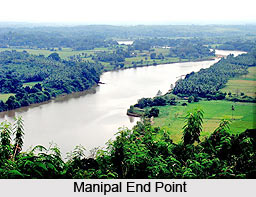 Manipal in Udipi District of Karnataka is a university town and it is a suburb within Udupi city and is administered by the Udupi City Municipality. Manipal is also the international headquarters of Syndicate Bank. A regional Information Technology hub, Manipal has one of the highest densities of mobile phone users in India. The Manipal Press, responsible for printing the Harry Potter series in Hindi and other Indian languages, is also headquartered in Manipal.
Manipal in Udipi District of Karnataka is a university town and it is a suburb within Udupi city and is administered by the Udupi City Municipality. Manipal is also the international headquarters of Syndicate Bank. A regional Information Technology hub, Manipal has one of the highest densities of mobile phone users in India. The Manipal Press, responsible for printing the Harry Potter series in Hindi and other Indian languages, is also headquartered in Manipal.
Location of Manipal
Manipal is located on the rocky hinterland of the Malabar Coast of south-west India, about 8 kilometers east of the Arabian Sea. From its location on a plateau, it commands a panoramic view of the Arabian Sea to the west and the Western Ghats Mountain Range to the east. Manipal is the home to the Manipal University. Manipal University attracts over twenty five thousand students every year. It is situated 5 km (3.1 mi) from the temple city of Udupi and 65 km (40 mi) north of Mangalore, Manipal was previously part of the Shivalli village panchayat.
Name Derivation of Manipal
The name is derived from "Mannu" and "Palla", anglicised to Manipal. Mannu means mud and Palla means lake in Kannada and Tulu Languages. This 400 meter lake, after which Manipal is named is located in the middle of the town, and offers boating facilities. Manipal was once a barren hill with few trees. This hill was transformed to a University town by Dr. T. M. A. Pai who first started the Kasturba Medical College in 1953, now a part of the university.
Climate of Manipal
Manipal is enjoying tropical climate with daily temperatures averaging 27 degree Celsius. From June - August, Manipal witnesses one of the most extreme monsoons in the world, with the annual precipitation ranging from 500-560 cm (200-220 in). The months of March - May are hot and humid, with the daily temperatures typically peaking at 35 Degree C (95 Degree F).

Education of Manipal
Manipal gained prominence in the mid 1950s, when its founder Dr. T.M.A. Pai founded the Kasturba Medical College in 1953. He later went on to find the Manipal Institute of Technology in 1957 and later 21 other colleges, all of which became a part of Manipal University in 1993.
Economy of Manipal
Manipal is a main technology and medical research hub, with major conferences and seminars organised almost every week. Since the establishment of MUTBI, the in-house business incubator of the university, a large number of student-run technology and media start-ups have sprung up.
Tourism in Manipal
Tourism in Manipal covers many tourist attractions. Tiger Circle, popularly referred to by its initials by the locals and the university community is the main commercial center in Manipal. Manipal has a planetarium named after Dr. Pai. It is the second oldest planetarium in the state of Karnataka, after Nehru Planetarium of Bengaluru. At one end of Manipal is End Point, which is a cliff overlooking the Swarna River. From this point, one can see the Arabian Sea in the western horizon and the Western Ghats in the eastern horizon. Malpe beach is located about seven kilometres from Manipal.
Agumbe, a popular hill station on the Western Ghats is around fifty kilometres east of Manipal, private buses ply daily to Agumbe. The major religious centre Sringeri is at distance of 88 kilometres from Manipal.
Visiting Information
Manipal is connected to Mangalore and Bangalore by several bus services, including the government run KSRTC. Buses leave Manipal for Mangalore every thirty minutes and for Bangalore every day. The nearest airport is Mangalore International Airport (formerly Bajpe Airport), which is located around 50 km (31 mi) from Manipal, connecting it to Indian cities like Mumbai, Bangalore and Delhi and internationally to the middle eastern countries like Kuwait, Bahrain, Qatar, Saudi Arabia, and United Arab Emirates. Buses also connect Manipal directly to the Bangalore International Airport, to cater to the large number of international students studying at the university. The nearest railway station is located about four kilometres west of Manipal, in Udupi on the Konkan railway line.



















